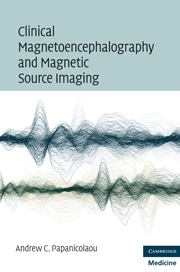Book contents
- Frontmatter
- Contents
- Contributors
- Preface
- Section 1 The method
- 1 Basic concepts
- 2 The nature and origin of magnetic signals
- 3 Recording the magnetic flux
- 4 Overview of MSI using the single equivalent current dipole (ECD) model as an example
- 5 The fundamental problems of MSI
- 6 Head models
- 7 Source models – discrete source models
- 8 Source models – distributed source models
- 9 Source models – beamformers
- 10 Pragmatic features of the clinical use of MEG/MSI
- Section 2 Spontaneous brain activity
- Section 3 Evoked magnetic fields
- Postscript: Future applications of clinical MEG
- References
- Index
10 - Pragmatic features of the clinical use of MEG/MSI
from Section 1 - The method
Published online by Cambridge University Press: 01 March 2010
- Frontmatter
- Contents
- Contributors
- Preface
- Section 1 The method
- 1 Basic concepts
- 2 The nature and origin of magnetic signals
- 3 Recording the magnetic flux
- 4 Overview of MSI using the single equivalent current dipole (ECD) model as an example
- 5 The fundamental problems of MSI
- 6 Head models
- 7 Source models – discrete source models
- 8 Source models – distributed source models
- 9 Source models – beamformers
- 10 Pragmatic features of the clinical use of MEG/MSI
- Section 2 Spontaneous brain activity
- Section 3 Evoked magnetic fields
- Postscript: Future applications of clinical MEG
- References
- Index
Summary
Although clinically useful MEG recordings can be – and have been – obtained with neuromagnetometer systems featuring a few sensors (whether gradiometers or magnetometers) that cover only part of the head surface, whole-head systems are far superior and are, therefore, recommended for all clinical applications. At this point the relative merit of the density of sensors, which varies depending on the model of the neuromagnetometer, has not been established, so there are no pragmatic grounds for recommending particular models featuring more – or fewer – sensors or channels.
The dewar cavity in most current whole-head systems is made to accommodate heads of all sizes, but often, especially when recordings are made of children, the head may assume different positions relative to the sensors. The recommendation in these cases is that the head be kept at the center of the dewar cavity or adjusted such that the area of the brain studied is closest to the corresponding set of sensors to improve the SNR. When, for example, the frontal lobes are of special interest, the dewar should be lowered over the forehead, even if that position increases the distance of the occipital regions from the corresponding sensors.
Whatever the position of choice, the head should be fixed during the recording using soft materials to insure maximum comfort. However, since the head position may shift during a recording session in spite all precautions, and given that such shifts may adversely affect the process of estimation of the brain sources of the recorded signals, head-motion correction procedures can be implemented.
All recordings should be made with the door of the magnetically shielded room (MSR) closed to reduce the amount of environmental noise.
- Type
- Chapter
- Information
- Publisher: Cambridge University PressPrint publication year: 2009

